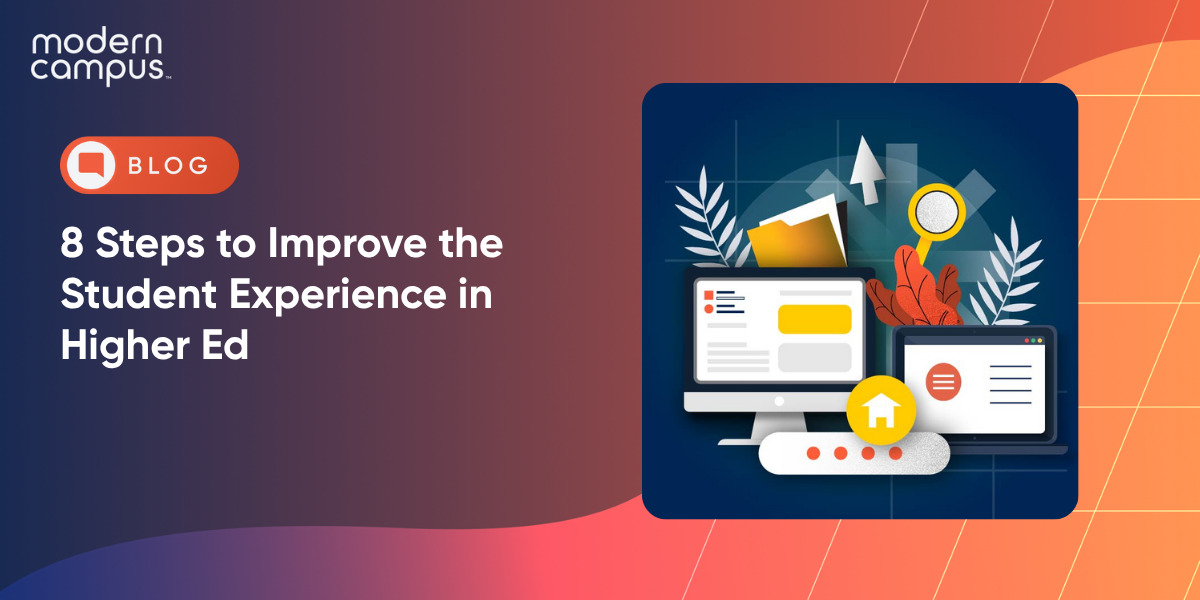8 Steps to Improve the Student Experience in Higher Ed
A great student experience is more than good grades and graduation rates. It's about feeling seen, supported and empowered.
From enrollment to graduation, learners expect their academic journey to reflect the personalized, on-demand service they receive in other parts of their lives. When students feel connected to their campus, goals and future careers, they’re more likely to stay enrolled, succeed academically and engage long after they leave.
Over 70% of students say feeling a sense of belonging is one of the most important factors in their educational experience. That’s why creating a holistic student experience is essential. Institutions that get this right are improving retention and satisfaction while building long-term relationships that support learners for life.
What Is The Student Experience?
The student experience goes far beyond lectures and lab reports. While academics are foundational, they’re just one piece of a much bigger picture. Campus life, co-curricular involvement, quality housing and dining, access to support services and a genuine culture of inclusion all shape how students feel about their time at an institution. When students have access to what they need emotionally, socially and academically, they’re more likely to stay engaged, perform well and feel like they belong.
How Do Institutions Measure the Student Experience?
To truly improve the student experience, colleges need actionable insights. This typically includes analyzing survey data, tracking key metrics like retention and graduation rates and gathering honest feedback through focus groups and social media.
Some institutions are even using tools like continuing education registration software to collect real-time engagement data from a wider pool of learners. When feedback loops are strong, decision-makers can adapt programs, services and support systems based on what students actually need.

Why It Matters More Than Ever
A strong student experience reflects how deeply an institution values its learners. Put aside prestige and rankings to design an environment where students feel supported, included and empowered to succeed. When students have a positive experience, they’re more likely to stay enrolled, participate in campus life and take ownership of their learning journey. In turn, institutions benefit from stronger retention, higher student satisfaction and more graduates who are ready to thrive beyond the classroom.
How To Improve The Student Experience In Higher Education
Elevating the student experience requires a coordinated, campus-wide effort rooted in data, technology and empathy. From streamlining administrative tasks to expanding flexible course options, institutions must address the full spectrum of what learners expect.
Whether you're looking to enhance engagement, increase enrollment or reduce staff time spent on manual processes, using tools like a student information management system can help bring these strategies to life. Below are some of the most impactful ways institutions can reimagine the student learning experience both inside and outside the classroom.
1. Understand Students' Needs With Continuing Education Registration Software
Improving the student experience starts with truly understanding your learners, including who they are, what they need and where they may be struggling. Institutions can collect this insight through surveys, focus groups and data gathered from online registration systems and continuing education registration software. These tools help reveal patterns across diverse student populations, including adult learners, first-generation students and international attendees.
Beyond demographics, it’s critical to understand student goals, motivations and challenges. Course catalog software can support this effort by helping students explore offerings that align with their academic interests, career aspirations and ability to manage their own classes with confidence. When institutions take time to evaluate both qualitative and quantitative data, they’re better equipped to design inclusive, student-centered experiences that drive engagement, increase enrollment and support long-term success.
2. Empower Students to Have a Voice and Reach Their Full Potential
Creating opportunities for students to voice their unfiltered opinions empowers them to participate actively in their learning development and educational environment.
Student councils, suggestion boxes, student journalism and regular town hall meetings can be instrumental in encouraging students to express their concerns, suggest improvement and collaborate with faculty and staff on decisions that impact the campus community.
Additionally, empowering students to involve themselves in continuous campus improvements helps those learners develop essential leadership skills that are highly valued by employers. Opportunities like student advisory boards, feedback forums and co-curricular project leadership give students a voice and real-world experience.
Tools like higher education texting platforms can encourage two-way communication between students and staff, making it easier for learners to share ideas, ask questions and contribute to institutional growth. Hearing from your students allows you to better understand their interests, and inviting them into the problem-solving process promotes workforce readiness. It’s a win-win.

3. Enhance Campus Facilities and Services via Continuing Education Management Software
A thriving campus community is more than just a collection of buildings; it's a dynamic ecosystem that profoundly influences the student experience.
Regular maintenance, accessibility improvements and the introduction of modern amenities are crucial in maintaining a comfortable, welcoming environment where students are eager to learn and engage.
Institutions should provide well-equipped libraries, tech-enhanced laboratories and engaging recreational spaces. Collaborating with accessibility services during the design phase will help meet the needs of students with disabilities, and maintaining recreational spaces—such as parks, sports facilities and communal areas—promotes a healthy balance between academic performance and personal development.
4. Foster a Sense of Community and Lifelong Learning
Building a strong sense of community is a cornerstone of student success. When learners feel connected to their peers, faculty and campus culture, they’re more likely to persist, thrive academically and engage beyond graduation.
First-year orientation programs lay the foundation, but institutions must continue nurturing that connection throughout a student’s journey. Encouraging involvement in student clubs, campus events, service projects and co-curricular programming fosters a sense of belonging and builds essential social-emotional skills. Using student engagement software can amplify these efforts by helping students discover relevant opportunities, track their participation and develop soft skills tied to career readiness. When learners feel part of something bigger, their satisfaction, retention and long-term loyalty all grow stronger.
Through those benefits, student engagement is positively associated with increased retention, persistence and on-time graduation. Students who are highly engaged with their institutional community, whether in-person or virtually, also maintain higher GPAs, are more likely to feel satisfied with their higher ed experience and are deemed more career-ready by employers.
5. Leverage Technology for Online Registration and Continuing Education Programs
Learners live in a digital-first world, and they expect their education to keep pace. From online shopping to booking appointments, Gen-Z is used to fast, intuitive experiences. If your institution’s systems feel clunky or outdated, students will notice and may look elsewhere.
To meet these expectations, institutions must adopt technology that simplifies the path from interest to enrollment. That means offering mobile-friendly course browsing, flexible online registration tools, intuitive class registration experiences and a registration system that adapts to different learner needs, including those exploring continuing education offerings or pursuing non-degree programs. These features support traditional students, working adults, career changers and remote learners.
Virtual campus tours, webinars and online forums can make a huge difference for students who can’t visit in person. Personalized websites and portals further enhance the digital student experience by connecting learners with resources, events and support services tailored to their interests. When done right, tech builds trust, increases enrollment and supports a more connected learning journey.
6. Prioritize Student Mental Health and Well-Being
Investing in students’ mental well-being is both a moral imperative and essential to the institution’s longevity. Two out of five undergraduates say they frequently experience emotional stress, and more than one in five American adults lives with a diagnosable mental illness.
Institutions can provide counseling services, including individual therapy, support groups, roommate mediation and sobriety coaching, to help students manage their stressors and persist in their education.
Academic support services, financial resources and community engagement can also go a long way in helping students develop effective coping mechanisms, maintain healthy habits and persist in their education.

7. Foster Faculty-Student Interactions
Students thrive when they feel seen and supported by the people teaching them. Strong relationships with instructors can improve academic performance, boost confidence and increase on-time graduation rates. These connections also shape how students perceive the value of their education and whether they feel empowered to reach their full potential.
To strengthen these bonds, institutions should adopt high-impact practices. Prioritize small class sizes, accessible office hours and inclusive classroom environments. Encouraging faculty to take part in co-curricular activities, lead mentorship programs or advise student organizations adds another layer of engagement.
Equipping instructors with ongoing professional development opportunities helps them refine their teaching strategies, build rapport with students and support a wider range of learning styles. When students and faculty connect on a deeper level, it cultivates trust, builds critical skills and contributes to a richer, more rewarding educational experience.
8. Improve Career Development Services
Career development is a vital part of the student experience that bridges the gap between education and employment. When students clearly see how their classes connect to real-world opportunities, they’re more motivated to persist, graduate and succeed after college.
Education providers are expanding their offerings with internship programs, networking events, resume workshops and employer partnerships that align with workforce development needs and offer pathways to earn continuing education credits. A robust learning management system can support these efforts by centralizing career-related resources, hosting virtual events and tracking students’ progress toward career readiness milestones.
Additionally, career centers can boost engagement by integrating personalized advising, alumni mentoring and access to tools that help students identify marketable skills tied to their programs. When career development is embedded across the student journey, it empowers learners to make informed decisions, build confidence and enter the job market prepared to thrive.
Create a Student Experience That Drives Success—From Enrollment to Graduation
By listening to students, investing in modern tools and creating inclusive, supportive environments, institutions can significantly improve the student experience. From streamlined services and stronger community connections to tech-powered learning and personalized career development, each initiative contributes to a more meaningful, successful journey. When students feel valued and empowered, they’re more likely to stay enrolled, achieve their goals and become lifelong champions of your institution.
At Modern Campus, we help institutions deliver exactly that. Our purpose-built solutions, from continuing education registration software to student engagement tools and career development support, empower colleges and universities to meet learners' needs. With technology that enhances every step of the learner-to-earner journey, we partner with institutions to create modern, personalized experiences that attract, engage and retain students for life. Request a demo today to reimagine your student experience.
Last updated: March 24, 2025




